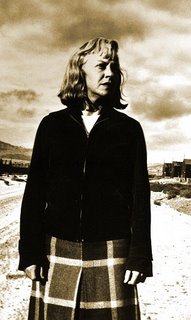Estelle (Peck) Ishigo (1899 -1990)
Man. I am glued to PBS these days. Lots of great fodder for the brain and spirit...
I saw a wonderful documentary the other day called, Days of Waiting. It is a memoir of sorts about a woman named Estelle Ishigo and her days spent living in an internment camp during WWII. She was a caucasian woman, married to a Japanese man. This fact is actually an insignificant theme in the documentary, but it did play a pivotal role in the path that her life would take.
The interracial marriage back then, while it was "taboo" in those times to marry outside of your race, was pivotal because it took her life in in a totally different direction that led her to experience life interned in the camp. When WWII began, the Japanese Americans were told they were being sent to camps. She had the option to separate from her husband because she was "fortunate" to be caucasian. She chose to stay with her husband and that sent her life down this path that has culminated into a wonderful documentary that really touched me. What if she had chosen to separate from her husband when all the Japanese Americans were being sent away? Amazing how one seemingly obvious, or not-so-obvious choice sets things in motion for all of history.
Throughout her years spent in the camps, she sketched pictures and recorded her thoughts and experiences. Her story was beautifully told and I highly recommend catching it if you can. She wrote a book called, Lone Heart Mountain. You can be sure I'm picking up a copy to read!
Estelle Peck (1899-1990) was born in Oakland, California and moved with her family to Los Angeles at the age of twelve. While studying at the Otis Art Institute she met Arthur Shigeru Ishigo, a San Francisco born Nisei. Anti-miscegenation laws at the time prohibited interracial couples from marrying, so in 1928 Peck and Ishigo took a trip across the border to Tijuana to be wed. Shunned by her family and other European Americans, the couple lived among the Japanese American community. With the outbreak of World War II, Ishigo chose to accompany her husband into the American concentration camps. In the Pomona detention center in California and in the Heart Mountain, Wyoming camp, she lived with other Japanese Americans. In Heart Mountain she worked as an illustrator for the War Relocation Authority reports division and was granted permission to draw and sketch throughout the camp. After the camp was closed, the couple moved to a trailer camp in Burbank, California where she continued to make her art. Estelle Ishigo's drawings of the incarceration were published as Lone Heart Mountain in 1972. In 1990, she was the subject of the Academy Award winning documentary, Days of Waiting. Drawings, sketches, watercolors and documents are included in this artist's collection.



2 Comments:
I'm glad you posted this, it's interesting. Both my husband's parents, as well as all of their family were interred(sp?) at the camps. We went to an exhibit several years back in SF about the internment camps.
You know, I minored in history in college and I don't recall learning one thing about the camps. It wasn't till I got to know my husband's family that I heard about 'camp'.
Thanks for posting this, I wish I had seen the documentary.
I love your website. It has a lot of great pictures and is very informative.
»
Post a Comment
<< Home